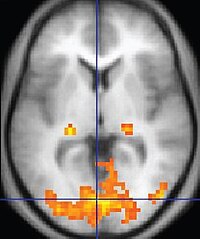
Photo from wikipedia
BACKGROUND Activation mapping using noninvasive electrocardiographic imaging (ECGi) has recently been used to describe the physiology of different cardiac abnormalities. These descriptions differ from prior invasive studies, and both methods… Click to show full abstract
BACKGROUND Activation mapping using noninvasive electrocardiographic imaging (ECGi) has recently been used to describe the physiology of different cardiac abnormalities. These descriptions differ from prior invasive studies, and both methods have not been thoroughly confronted in a clinical setting. OBJECTIVE The goal of the present study was to provide validation of noninvasive activation mapping in a clinical setting through direct confrontation with invasive epicardial contact measures. METHODS Fifty-nine maps were obtained in 55 patients and aligned on a common geometry. Nearest-neighbor interpolation was used to avoid map smoothing. Quantitative comparison was performed by computing between-map correlation coefficients and absolute activation time errors. RESULTS The mean activation time error was 20.4 ± 8.6 ms, and the between-map correlation was poor (0.03 ± 0.43). The results suggested high interpatient variability (correlation -0.68 to 0.82), wide QRS patterns, and paced rhythms demonstrating significantly better mean correlation (0.68 ± 0.17). Errors were greater in scarred regions (21.9 ± 10.8 ms vs 17.5 ± 6.7 ms; P < .01). Fewer epicardial breakthroughs were imaged using noninvasive mapping (1.3 ± 0.5 vs 2.3 ± 0.7; P < .01). Primary breakthrough locations were imaged 75.7 ± 38.1 mm apart. Lines of conduction block (jumps of ≥50 ms between contiguous points) due to structural anomalies were recorded in 27 of 59 contact maps and were not visualized at these same sites noninvasively. Instead, artificial lines appeared in 33 of 59 noninvasive maps in regions of reduced bipolar voltage amplitudes (P = .03). An in silico model confirms these artificial constructs. CONCLUSION Overall, agreement of ECGi activation mapping and contact mapping is poor and heterogeneous. The between-map correlation is good for wide QRS patterns. Lines of block and epicardial breakthrough sites imaged using ECGi are inaccurate. Further work is required to improve the accuracy of the technique.
Journal Title: Heart rhythm
Year Published: 2019
Link to full text (if available)
Share on Social Media: Sign Up to like & get
recommendations!